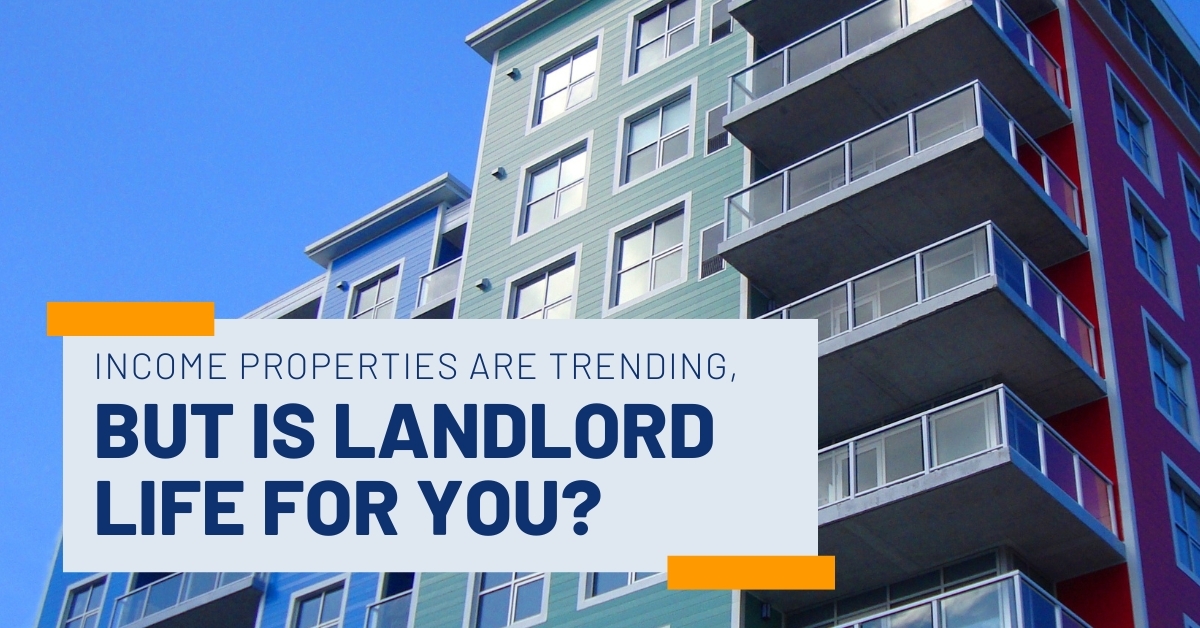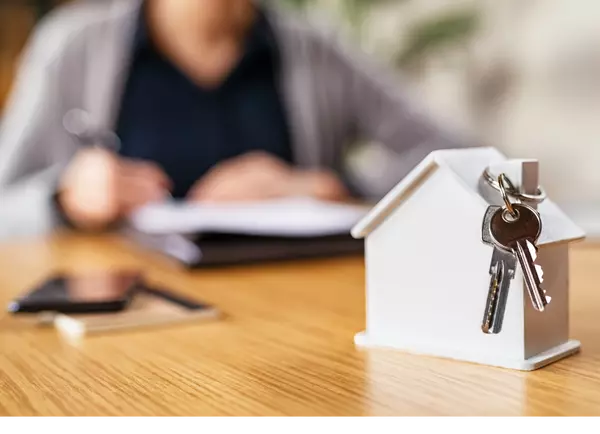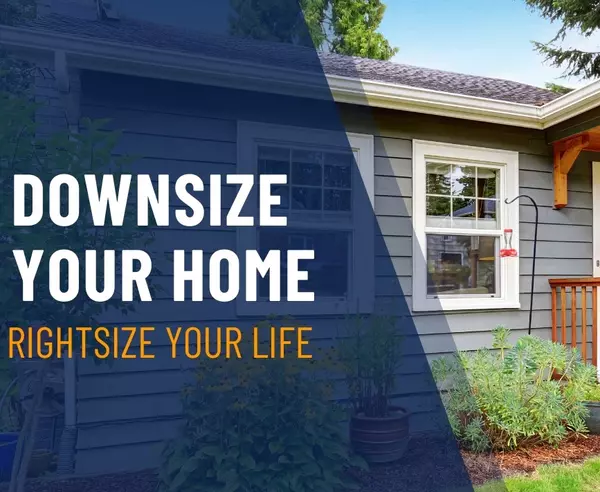Income Properties are Trending, Are you Ready to Invest?

Income Properties Are Trending, But Is Landlord Life for You? 12 Sep 2023 by Jo Schultheiss If the thought of investing your money into brick and mortar—or perhaps some stylishly-painted siding—excites you, join the club.Investing in real estate has long been one of Americans’ favorite ways to grow their wealth. In fact, over 70% of single-family rental properties are currently owned by individual investors rather than corporations, according to Census data.1Moreover, a decade’s worth of Bankrate surveys has found that Americans often prefer real estate for long-term wealth building over other investments. According to Bankrate’s latest survey, for example, Americans have historically embraced real estate, in part, because of the strong return on investment it can offer—especially to investors willing to stick with a property over time.2 It’s also a popular way to hedge against inflation since both rental income and property values tend to rise in tandem with overall prices.3Now, as higher interest rates continue to push priced-out homebuyers to the sidelines, a new crop of “mom and pop” investors are eyeing the mushrooming rental market as a potential goldmine.4 Interest in buying a home to both live in and rent is also on the rise, especially amongst cash-strapped buyers looking to supplement their mortgage payments.5But how do you know if you’re well-suited to take advantage of these real estate investment opportunities? Here are three signs that owning a rental property could be right for you.1. YOU’RE A HOMEBUYER WHO WANTS HELP COVERING THE MORTGAGEIf you’re looking for a creative way to buy a home without overspending, “house hacking” could be the answer. Increasingly popular with first-time homebuyers and budget-conscious investors, house hacking simply means buying a home that you intend to live in while renting out a portion of it to one or more tenants.5House hacking also tends to be easier to break into than traditional real estate investing since you don’t need as high a credit score or as large a down payment to qualify for a mortgage. In fact, some government-backed mortgage programs will let you buy a primary residence with little to no money down.6 Buying a home you don’t plan to live in, by contrast, may require you to put down as much as 15% to 25% to qualify for a loan.7If you house hack, the money you collect for rent each month can help cover your mortgage and other homeownership expenses. Depending on your setup, you may also be able to save on utility bills by splitting them with your tenant or tacking a portion onto their monthly rent. Another major advantage of house hacking is that it entitles you to certain tax benefits and deductions available only to landlords.8When it’s time to start your search, we can help you find a property that’s ideal for house hacking, such as a house with a walkout basement, a multifamily unit, or a home with enough outdoor space to build an accessory dwelling unit or garage apartment.2. YOU’RE AN INVESTOR LOOKING FOR STEADY AND RELIABLE INCOMEIf you’re not crazy about the idea of a live-in tenant but still desire an additional stream of income, a dedicated long-term rental property could be a better option for you. Besides the monthly proceeds, purchasing a rental home can also add diversity and long-term stability to your investment portfolio and help you build wealth over time.9According to data from the Federal Reserve, real estate owners have historically prospered. In early 2020, for example, the median home was worth almost triple what it was 30 years prior. Then, during the pandemic-era real estate boom, average home prices grew at an especially frenzied clip, climbing by nearly 50%, on average, in just two and a half years.10However, the rate of appreciation can be hard to predict, so it’s prudent to invest in a property that also offers positive cash flow, which means the rent you take in exceeds your expenses. This strategy helps to ensure that you’ll put money in your pocket each month, even if the property’s value takes time to grow.While today’s higher mortgage rates can make it more challenging for landlords to turn a profit, investment opportunities aren’t reserved for cash buyers. In fact, currently, almost 60% of real estate investors take out a loan to finance their purchase, according to Thomas Malone, an economist at the real estate data firm CoreLogic.4 He also notes that more small investors are stepping in to meet demand for rental housing, which has grown since many would-be buyers remain priced out of the purchase market.4If you want to explore opportunities for a residential rental property that’s good for your wallet and attractive to renters, we can help. Reach out with questions or to schedule a free consultation.3. YOU’RE AN EXPERIENCED INVESTOR LOOKING TO MAXIMIZE YOUR POTENTIAL RETURNSAnother increasingly popular way to draw income from an investment property is to convert it to a short-term vacation rental. But beware: This strategy can be riskier as some municipalities have tightened rental restrictions and others are suffering from market oversaturation.11,12. We are blessed with a very strong Short Term Rental opportunities in the Smoky Mountains and Lake Communities.With that said, if you’re an experienced investor who can afford to take on some uncertainty, then investing in a short-term rental could make sense for you.If you find the right property, for example, you could earn significantly more renting it short-term on a platform like Airbnb than if you rented the home to a long-term tenant.11The key is to keep it occupied as much as possible at a premium nightly rate. To do that, you’ll need some marketing savvy, hospitality skills, and business acumen. Of course, you can always hire a professional property manager, but you’ll need to factor the cost into your budget.The vacation rental market enjoyed a boom during the pandemic, and some inexperienced investors are finding they bit off more than they can chew. As a result, there’s an opportunity to snap up some of these properties, but you’ll need some cash on hand and a willingness to learn the business.12We can help you scout opportunities in our local market- the Smokies are Calling!BOTTOMLINEInvesting in real estate can be a great way to build your wealth long-term and earn some extra income. But to make the most of your investment, it pays to be strategic.Call us for a consultation so we can discuss your goals and budget. We’ll help you discover neighborhoods with the best income potential, point out the homes most suited to renting, and help you brainstorm the best investment strategy for you.Before you take the plunge, make sure you can answer “YES” to these three questions:1. Are you ready to be a landlord?Owning a rental property can take a lot of time and energy. You’re not just buying passive income, you’re also building sweat equity since the time you spend maintaining, marketing, and managing your rental can add up quickly. So be prepared to do some soul-searching to ensure you’ll not only flourish as a landlord, but actually enjoy it.If you want to invest in real estate but aren’t prepared to put in the day-to-day effort required, we can refer you to a property management service for help.2. Can you afford to invest in real estate?The last thing you want is to get over-extended with your new real estate venture. Besides the cost of purchasing the property, you’ll need to consider additional expenses, like property taxes, insurance, administrative costs, and maintenance and repairs. You will also need a cash reserve for unexpected issues or potential vacancies.We can help you run the numbers to determine whether you can charge enough rent to offset your expenditures.3. Have you found the right income property?Even if you’ve got your finances in order and are emotionally ready to invest, your success as a landlord will also depend on the property you buy. The criteria for a good rental home and a good family home are often different, so it’s important to lean on professionals for advice.We can help you find an ideal rental property, taking into account your budget, risk appetite, and investment goals. If you decide to invest in a different area, we’ll connect you with an agent who’s more plugged into that community. Reach out today to schedule a free consultation.The above references an opinion and is for informational purposes only. It is not intended to be financial, legal, or tax advice. Consult the appropriate professionals for advice regarding your individual needs.Sources: PR Newswire – https://www.prnewswire.com/news-releases/census-data-show-individuals-continue-to-own-largest-share-of-single-family-rental-homes-301725024.html Bankrate – https://www.bankrate.com/investing/survey-favorite-long-term-investment-2022/ Forbes – https://www.forbes.com/sites/forbesbusinesscouncil/2022/04/14/why-income-generating-real-estate-is-the-best-hedge-against-inflation/?sh=1081ce921746 MarketWatch – https://www.msn.com/en-us/money/realestate/another-challenge-for-homebuyers-more-investors-are-snapping-up-homes-and-40-of-them-are-using-cash/ar-AA1foWSB Realtor.com – https://www.realtor.com/advice/buy/on-the-house-house-hacking-your-way-into-your-first-home/ NerdWallet – https://www.nerdwallet.com/article/mortgages/government-home-loans LendingTree – https://www.lendingtree.com/home/mortgage/down-payment-for-rental-property/ Quicken Loans – https://www.quickenloans.com/learn/house-hacking Investors Business Daily – https://www.investors.com/etfs-and-funds/personal-finance/rental-properties-investing-experts/ St. Louis Fed FRED Economic Data – https://fred.stlouisfed.org/series/MSPUS Story by J.P. Morgan – https://story.jpmorgan.com/real-estate-news/thinking-about-investing-in-short-term-rentals-heres-what-to-know Skift – https://skift.com/2023/07/21/short-term-rental-saturation-leads-to-a-correction-and-lots-of-home-sales/ Jo Schultheiss Jo Schultheiss is the committed agent you’ve been looking for. We promise to listen to your concerns and keep you informed of the nuances in our local market so you can reach all of your real estate goals. Reach out today for help with your home buying, selling, or investing needs! 5.0 7 Client Recommendations The Real Estate Firm 1537 Western Ave Knoxville, TN 37921 United States treftn.com/ 1 (865) 770-4030 Accessibility Statement
Read More-

Home buyers who do mortgage loan shopping can avoid leaving money on the table. Whether you’re shopping for new bed sheets or a new car, the drill is usually the same. Hit the reviews, check with friends, and scope out the best deal. After all, who wants to buy a car that racks up repair bills right away? Yet when picking a mortgage loan, borrowers don’t always think about comparison shopping. In a Bankrate survey of recent home buyers, 12% of millennials said they believe their mortgage rates were too high. Some buyers may think that when mortgage rates are low, they don’t need to shop for the best offer. But even a few basis points can make a difference of thousands of dollars over the life of a loan, according to Bankrate, the Consumer Financial Protection Bureau, and the Federal Trade Commission. You may think mortgage shopping is about as much fun as prepping for a tax audit. It’s true that comparing home mortgages can get complicated. But you don’t need a finance degree to make an informed decision. Here are some steps to get there. Find a Few Lenders When looking for lenders to consider, loan officers recommend going to a few sources: Locals you know and trust: “Make sure the lenders you’re comparing come from referrals from local people you know who’ve worked with them — like your friends or relatives,” advises Jeff Koch, senior vice president of residential lending at Draper & Kramer Mortgage Corp in Schaumburg, Ill. “Wherever you have trust established would be a good source.” Your real estate agent: “If you’re working with a real estate agent, find out if they have any feedback or advice on a lender or a loan officer,” recommends Jim DeMarco, branch manager and senior loan adviser at Flagstar Bank in Seattle. Online reviews: These can be a good starting point, DeMarco says. “If you see a lot of really good reviews, that means people are taking the time to provide them.” Have an Intro Mortgage Loan Meeting During a meet and greet, you and the loan officer will usually ask each other questions, and the loan officer will use that information to assess your qualifications. That may sound cut and dried, but the meeting should be fluid based on what you’re ready to do. Typically, the loan officer would schedule a meeting focused on comparison shopping separately. If that sounds painful to borrowers who want to (literally) get moving, no worries, Koch says. “The borrower may be well versed and want to get right to what’s most relevant for them, which are the financial and comparison details. But a lot of people need to go over their own questions or cover key topics first.” Want to meet virtually? “Some folks are just more comfortable virtually, and that’s OK,” DeMarco says. “I’ve closed loans with people I’ve never talked to on the phone. It’s all via text.” Interview the Mortgage Loan Officer Whichever way you choose, this meeting is prime time to interview the loan officer. Borrowers need to find someone who will be in there with them and can problem solve. “We call unanticipated problems ‘icebergs,’” DeMarco says. “You think there’s smooth sailing. And then, suddenly, you smack into an iceberg.” Check out the lender’s communication strategy and their process for delivering on time. “The process is highly complex, and you’d think professional lenders all would have mastered it. That’s not the case,” says Koch. “When a loan isn’t delivered on time, people’s finances and lives are basically balanced on the head of a pin, which is the closing date.” To avoid problems, ask questions like these: Fact finding about the process: Would you take me through the process? What should I expect? What will I need to supply? Compatibility with the loan officer or mortgage banker or broker: What’s your communication style? Are you willing to communicate virtually? When would I work with you? Are you available in the evenings? Will I work with you or a member of your team? What do you think of my time frame to get to closing? What if any problems do you foresee? Track record of loan officer and lender: How long do loans you process typically take to close? How would you expedite the process if there’s a tight time frame? About what percentage of loans you work on close on time? How many loans have you worked on that haven’t closed or haven’t met deadlines? What’s the biggest problem you’ve had with a loan and how did you fix it? Use the Meeting to Learn You can also use the meeting to clarify general info you’ve picked up online and talk about your concerns. DeMarco gives a couple of examples. “You may have switched careers or industries in the last year or started having bonus or commission income. Your research may have shown you can just divide your salary by 12 to figure monthly income. But it may not be as simple as that.” You’ll also want to bring up concerns like the impact on your credit score. Thirty-eight percent of buyers think comparing multiple mortgage offers in a short time will hurt their credit rating, according to a 2020 LendingTree survey. “As long as the lenders all pull the borrower’s credit within a couple of weeks, it’s counted as a single credit inquiry. So, it’s not a problem if they do it within a narrow band of time,” Koch explains. Get and Compare Financial Information Whether you’re looking at a federal form called a loan estimate or a precursor form called the fees worksheet, you’ll see a breakout of closing costs, explains Koch. “To compare the lender financials, you’ll want to drill down to origination charges in the lender section. Make sure you’re comparing apples to apples. If one lender is offering a 30-year fixed rate at 2.875% with no lender fees and another is offering 2. 75% with $1,500 in lender fees, those are unlike products. Get the fees at the same rate to find out which is less expensive.” 6 Tips to Get Mortgage Loan Information Comparison shopping can get complicated. Here are six ways to keep it simple: 1. Keep Your Pool Manageable Mortgage shopping “depends on the borrower and the personality type and how they’re wired,” Koch says. “The process can seem overwhelming. That’s why it makes sense to have a select few options to compare so borrowers can process and assimilate them.” 2. Get a Fees Worksheet The best way to compare effectively is to zero in on the fees worksheet, which the loan officer should provide. “You’ll be able to figure out just what the lender’s direct fees are, and you can make a nice, simple comparison,” Koch explains. 3. Understand a Fees Worksheet Versus a Loan Estimate The numbers on the worksheet are estimates and not locked in. Interest rates are fluid and change daily or even more often, DeMarco says. On the other hand, after you have a contract with a seller, “the loan estimate and loan application are where the information is binding, barring structural changes to the loan,” Koch says. Make sure the information reflects previous discussions with and disclosures by the loan officer. 4. Be Careful Interpreting Third-Party Fees Third-party fee estimates are included on the worksheet. Two lenders could each come up with different estimates for title, escrow, or appraisal fees, Koch explains. But not all are negotiable. For instance, the seller chooses the title company, so the lender doesn’t control the choice or the fees. The lender could be choosing the high or low end of a range, but it’s only an estimate. 5. Think About Timing Make sure lenders are using the same time frame for locking in pricing and that it will extend through the closing, Koch notes. “A lender might offer a rate that’s a lock for three weeks, but if you anticipate or know your closing date will be five or six weeks out, that’s a problem.” 6. Consider Applying for Loan Approval Before Finding a Property “Many lenders will not do this,” Koch says. “But some will allow borrowers to go through the formal underwriting process — not just pre-approval — without having a property. The borrowers can get a bona fide mortgage commitment with all of the major buyer financials truly underwritten at that point. Then when borrowers make an offer, they can close more quickly.” You’ll have to invest some time and effort into comparison shopping for a mortgage loan and selecting a lender and a loan officer. But your return on investment can pay off over the long haul.
Read More -

Interest rates are only one factor when it comes to buying a house now. Interest rates sure do get a lot of attention. But they shouldn’t be the only part of your home buying decision-making process. After all, the answer to the question “is right now a good time to buy a house” boils down to whether the time is right for you: To start your new chapter. To invest in what makes you happy. Interest rates don’t negate the benefits of buying a home. Unlike that other big-ticket purchase — a car — home value doesn’t take a nose dive once you get the keys. Quite the opposite. Is Owning a Home a Good Investment? Let’s dig into the advantages of buying a house. Benefit #1: Long-term Financial Growth When it comes to long-term, stable financial growth, real estate is your ace in the hole. If you bought a home 30 years ago for the median price at the time — about $105,900 — that same home would have appreciated by almost $280,000 in 2022 to about $384,900, according to the National Association of REALTORS®. Even factoring in the lowest point for the market in recent memory — the Great Recession — home values have risen over time, and have kept pace with inflation. Benefit #2: Building Equity The down payment and the principle in your monthly mortgage payment goes straight to your equity. Rent money just goes. That equity, an interest percentage in the home, gives you a lot of flexibility. You can: Trade up to your next home when the time is right; Tap equity to borrow money to pay for home repairs and renovations (making your home even more valuable!); or Use it to consolidate credit card debt or even help pay for college. (Just keep in mind when you use equity, your home becomes your collateral.) Thanks to equity, the typical net worth of homeowners is $300,000 compared with $8,000 for renters, according to 2022 NAR data. That’s a lot of financial leverage. What are the Tax Advantages of Owning a Home? Benefit #3: Tax Savings Believe it or not, savings and taxes can play together nicely. Equity is savings, and when you sell a primary residence, you don’t typically pay taxes on the gain. You can take up to $250,000 ($500,000 for a married couple) without owing taxes. So all that appreciation goes with you on your next adventure. Benefit #4: Deduction of Property Costs If you itemize, you also can deduct some of your property costs from your federal taxes. Those include the annual interest you pay on your mortgage, your state and local property taxes up to $10,000, and in the year you buy, some of the fees you paid to close on the home. Only itemize if it means you can claim more than the standard deduction, which for tax year 2022 is $12,950 for single filers and $25,900 for married couples. More Advantages of Buying a Home Benefit #5: Fixed-rate Mortgage Payment Unlike rent, your fixed-rate mortgage payments don’t rise over the years so your relative housing costs may actually go down the longer you own the home. That is, if your earnings go up, a static mortgage payment means your home debt load becomes a smaller percentage of your monthly nut. Here’s an example: Say your mortgage payment is $2,329 this year and your monthly gross salary is $6,667 (roughly $80,000 per year). That means you’re putting 35% of your salary toward the mortgage. Now, fast forward a few years. Say you saw 5% salary growth annually, and you’re at $7,700 gross per month. Your mortgage payment is still $2,320, but now you’re only spending 30% of your salary on your mortgage. Of course, keep in mind property taxes and insurance costs will likely go up. Benefit #6: Improved Credit Score Speaking of those mortgage payments: Each one, paid on time, is helping to further build your credit score. Benefit #7: Remodeling Your Dream Home One of the biggest pros of owning a home is that you can turn the house you can afford into your dream home – bit by bit. Those holes in the wall and paint colors your landlord freaked out about? No worries. You can upgrade amenities, décor, and style to your vision — whether that’s cottagecore, Barbiecore, or anything in between. Bonus Benefit: Work with a REALTOR® You don’t have to go through the buying, or selling, process alone. A REALTOR®, an agent who’s a member of the National Association of REALTORS® and subscribes to its code of ethics, has the expertise to help you assess the market; expand and reframe your home search into areas you might not have thought of; refer you to reliable lenders; and guide you through the offer, negotiations and closing. When the time is right to go forth, we’ve got you covered on every step of the buying process.
Read More 13 Small (and Affordable) Home Upgrades for Big Impact

Transform your home into a beautifully designed space — without the spendy price tag. Home improvement pros and DIYers tout a fresh coat of paint as a favorite among low-cost home upgrades that can make a huge impact. But what else can you do to accessorize and decorate? Sometimes the little things can make a bigger difference than you’d think. Professionals share the following easy and low-cost home upgrades to add a designer’s touch all around the house. These projects may even help increase your home’s perceived value. For the Bathroom 1. Frame It Estimated cost: starting around $100 That edgeless, builder-grade mirror hanging above the bathroom vanity may be prime for an update. Jessica Love, an interior designer with Urbane Design in Austin, Texas, suggests using DIY frame kits, like the ones from MirrorMate. Measure the mirror and choose from numerous frame styles and materials, like wooden walnut or shiny brass. The frame kit includes clips and metal strips to attach to the existing mirror. A once-forgettable mirror instantly looks customized and styled to the space, Love says. 2. Infuse Some Green Estimated cost: $5 and up Simply adding greenery can liven up bathroom spaces and soften harsh lines from all the heavy fixtures, designers say. Try a statement plant on the floor, like the vertical sword-shaped leaves of a snake plant or the feathery foliage from a bird’s nest fern. Or you could incorporate smaller plants, like a mini aloe in a white ceramic planter or an iron fern in a rounded marble vase. Many renovators say they’re incorporating greenery to update their bathrooms for aesthetics, air purification, and odor-fighting abilities, according to the 2022 U.S. Houzz Bathroom Trends Study, a survey of 2,500-plus remodeling homeowners. Tight on space? Love suggests topping a shelf or vanity counter with an air-purifying indoor plant on a natural tray (for texture) along with a favorite candle. 3. Modernize Hardware Estimated cost: hardware starting at about $2 apiece, faucets for $200 or less Just swapping out the faucets and drawer pulls is a small home upgrade that can refresh an outdated bathroom. Try trendy gold or black cabinet pulls or a modern boxy-style faucet. “Mixed metals are trending right now,” Love says. “We’re seeing black with brass and brass with chrome.” Love’s favorite resource for inspiration is Build.com, which features a variety of manufacturers and styles. 4. Soften the Lights Estimated cost: about $100 or less apiece ($40 to $120 per fixture for installation by an electrician) Wall sconces can warm up the bathroom lighting, says interior designer Jessica Nelson of Jessica Nelson Design in Seattle. She suggests wall sconces hung on each side of the vanity mirror in a black, brass, or chrome finish. The bulb color’s temperature is important, Nelson adds. “My sweet spot is between 2700K [Kelvin] and 3000K. I do not recommend going any cooler than that,” she says. “2700K is a crisp but warm white, and 3000K is my personal favorite. It’s a really soft warm light.” For the Bedroom 5. Add Molding to the Walls Estimated cost: about $200, including a designer’s input Installing molding on the walls behind the bed is an impressive home upgrade. Krisztina Bell, founder of No Vacancy Home Staging and Virtually Staging Properties in the Atlanta area, recently used black molding zigzagged across a wall to dress up a white, blank slate behind the bed frame. She says designers and woodworking artists are readily available on sites like Etsy.com (search under “professionally designed custom dimensional accent wall”). They will custom design a 3D digital model of the molding to fit your wall and provide an instruction packet, shopping list, and cutting and installation instructions so you can DIY. 6. Decorate With Mirrors Estimated cost: $150 to $250 “I love adding a statement wall mirror to a bedroom,” says Channa Alvarez, interior designer and production designer at Living Spaces, a national furniture retailer in La Mirada, Calif. She suggests hanging a new mirror above a nightstand, dresser, chest, or bed. Try a mirror in an unusual shape, like a diamond, hexagon, or square silhouette. “If you’re itching for a redesign but don’t want to spend so much, a mirror is the perfect buy. It’s simple, affordable, and light-enhancing.” For the Living Room 7. Texturize and Accessorize Estimated cost: $50 to $150 to update a few accessories “A room can appear one-dimensional when it’s missing texture,” says interior designer Lance Thomas of Thomas Guy Interiors in Lake Charles, La. Designers may add texture by incorporating dressers with fluted designs, chunky knit throws, velvet ottomans, or leather accent chairs. You can adapt that idea by scoping out items from other rooms in your house that you can mix in the living room to add texture and depth. Or shop secondhand stores for small items you can refinish, repurpose, or re-cover. For example, re-covered accent pillows are an affordable way to add texture to your furniture. “Perhaps the best thing about accent pillows is they’re an easy seasonal item, making your living room feel different without costing as much as a new furniture buy,” Alvarez adds. “Throw pillows are a great and inexpensive way to incorporate new trends or add color to your living room.” Also, functional accents — like a set of three seagrass baskets — can be great for a corner or near a fireplace, Alvarez says. Then, “place throw blankets in them to give the room a cozy, inviting feel.” 8. Wallpaper the Shelves Estimated cost: about $50 for a small roll For homeowners who may be too timid to jump on the wallpaper comeback trend, try it in small doses and with less commitment (especially when using a removable peel-and-stick type). Interior designer Mel Bean of Mel Bean Interiors in Tulsa, Okla., suggests adding wallpaper to the inside back of a bookcase or other shelving unit to dress it up. Recently, she used a jagged, striped gray-and-cream-colored wallpaper behind each shelf on an all-white built-in to add texture, color, and a more custom look. For the Kitchen 9. Bring in Some Bling Estimated cost: starting at $2 apiece for cabinet hardware, $60 to $150 for pendant lighting (extra $40 to $120 per fixture for installation by an electrician) Don’t let an all-white kitchen become boring, Bell says. “Add industrial or contemporary black hardware and lighting to make a kitchen look more chic. Gold is trendy; or chrome, nickel, brushed silver, and stainless steel hardware and lighting are always safe bets,” she adds. Bell likes sites such as Overstock.com, Wayfair.com, or Amazon.com for affordable, stylish mid-century mod, industrial, or futuristic pendant lighting options. For example, she used shiny gold canned pendants in an otherwise all-white kitchen to highlight the island. “Even just changing out one main fixture or series of pendants above a kitchen island can change the whole look of a room instantly without having to renovate the entire kitchen,” she says. 10. Dress Up the Pantry Estimated cost: starting at $1 each for baskets and glass jars Pantries have emerged as a kitchen favorite, so they’re a good choice for a home upgrade. They’re rated as essential or desirable by at least 80% of home shoppers, according to the National Association of Home Builders “What Home Buyers Really Want” consumer survey. Retailers such as the Container Store, Ikea, and Dollar General offer baskets and glass jars in all shapes and sizes. “Invest in a label maker and go to town organizing your pantry so everything matches and looks almost decorative or too pretty to take snacks from,” Bell says. “This helps create visual order in the space too.” For example, stow pasta in a glass container, put the packaged bread and other products in shelf-sized baskets, and color coordinate the canned goods. For Outdoors 11. Accentuate With Flower Boxes Estimated cost: $150 Boxes filled with flowers along the bottom ledge of your outside windows can enhance your home’s architecture and colors. “Flower boxes have this cozy and charming feel,” says Jackie Mosher, co-founder of Dzinly, a company in Royal Oak, Mich., that helps homeowners and real estate professionals digitally design exteriors. “They can add interest, dimension, and some personality.” Fill them all year-round. Mosher suggests using three different types of flowers (for example, greenery, a taller plant in the center, and a colorful accent flower). The size, proportion, and positioning of flower boxes are important; don’t overdo it, she adds. Not every window needs one. Maybe it’s just the large picture window or the windows on a second story. To test placement, Mosher suggests duct taping cardboard cutouts to the windows to view the possibilities before drilling any holes. 12. Swap Out Lighting Fixtures Estimated cost: $200 to $250 Bring in a statement light above the front door for a functional and dramatic home upgrade. A hanging pendant or chandelier on the front porch isn’t just for extra illumination. It can enhance curb appeal, Mosher says. She suggests a fixture that’s about one-third or one-fourth the size of the front door (including the trim) and having it hang about 66 inches from the ground. “So many times, we hang them too high,” she says. “Let your front porch light be the loudest. The lights on the exterior should be your jewelry — your ‘wow.’” If there’s no place for a pendant, upgrade the lights to the side of the door, such as with boxed lanterns in a black or antique bronze, she suggests. Her favorite site for inspiration: Bevolo.com, which recommends fixtures based on house style (modern, traditional, coastal, etc.). 13. Oversize the House Numbers Estimated cost: $150 to $200 The home’s address numbers may seem insignificant for the outside design, but Mosher calls them one of her favorite inexpensive home upgrades. Large format, sleek black address numbers can add a modern vibe to a home, she says. “House numbers are like adding a statement watch to your outfit. It pulls it all together.” The numbers can be in all-black or in colors, like even pink or teal, depending on the home’s style, she says. The placement varies too, from the side of the front door to above the garage or anywhere along the front. “These can become a focal point and add some flair,” she says. Mosher’s favorite site for inspiration for house numbers: Modernhousenumbers.com.
Read More
Recent Posts









